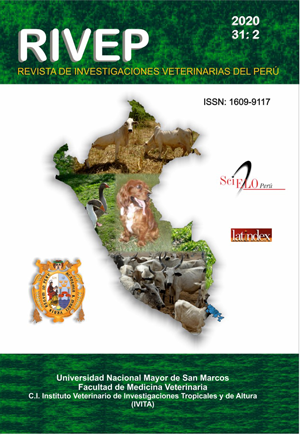The comparative analysis among Mediterranean hen breeds based on their morphological traits does not reflects relationships of origin or aptitude
DOI:
https://doi.org/10.15381/rivep.v31i2.17848Keywords:
cladistics, ethnology, morphology, Gallus, varietyAbstract
The aim of this study was to carry out the systematic classification in related groups and based on morphological similarities of 19 breeds of hens of the Mediterranean group. These breeds were 15 Spanish (Alicantina, Andaluza Azul, Cara Blanca, Castellana Negra, Empordanesa, Flor d’Ametller, Mallorquina, Menorquina, Murciana, Pairal, Penedesenca, Prat, Sobrarbe, Utrerana and Valenciana de Chulilla) and four Italians (Italiana, Livorno, Mericanel della Brianza and Paduana). The analysis included the evaluation of 17 qualitative morphological characteristics and was based on the principle of parsimony using Fitch method. The resulting phylogram should be interpreted as a group tree concerning the morphological relationships between breeds and not as a phylogenetic tree because does not allow a clear clustering of breeds according to their origin of purpose. This, together with the rates obtained for synapomorphy –shared homologous characters– and homoplasia –independently acquired parallel changes– higher in the former, allows to suppose that, although in the process of breed diversification, there may have been phenomena of convergence of morphological characters, the conservation phenomena of existing morphological characters have been greater. That is, there have been changes in the morphological models in the process of formation of the breeds, independent of their origin and aptitude.
Downloads
Downloads
Published
Issue
Section
License
Copyright (c) 2020 P. M. Parés-Casanova, J. Berenguer-Boix

This work is licensed under a Creative Commons Attribution-NonCommercial-ShareAlike 4.0 International License.
AUTHORS RETAIN THEIR RIGHTS:
a. Authors retain their trade mark rights and patent, and also on any process or procedure described in the article.
b. Authors retain their right to share, copy, distribute, perform and publicly communicate their article (eg, to place their article in an institutional repository or publish it in a book), with an acknowledgment of its initial publication in the Revista de Investigaciones Veterinarias del Perú (RIVEP).
c. Authors retain theirs right to make a subsequent publication of their work, to use the article or any part thereof (eg a compilation of his papers, lecture notes, thesis, or a book), always indicating the source of publication (the originator of the work, journal, volume, number and date).



